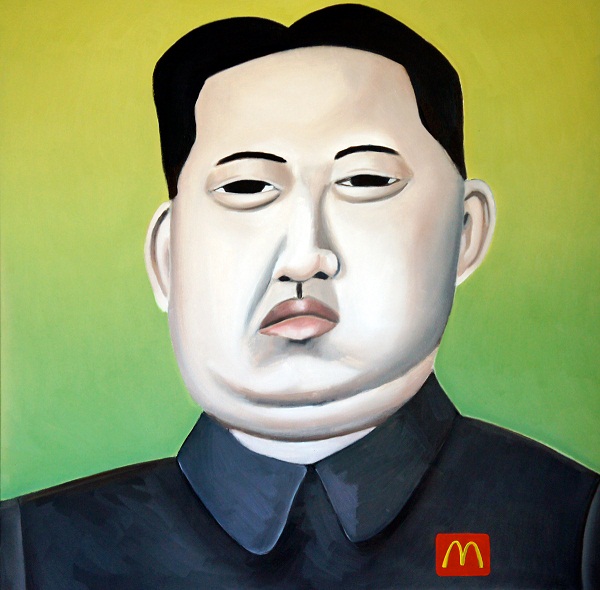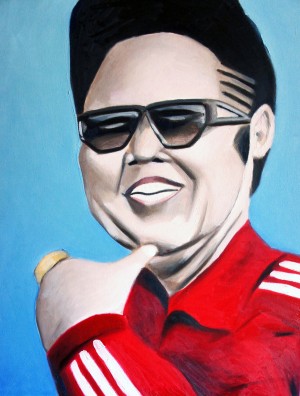Artist of the Week 8/22 – 8/28: Pete Kirill Merges the Line between Communism and Capitalism
GALO: In 2011, Chinese artist Lei Yixin’s 30-foot statue of Martin Luther King, Jr. created controversy. Many felt the sculpture’s design looked “too Asian” and that the posture was too confrontational. Did you receive any criticism; say by anyone who might have had some connection to the dictator?
PK: I wanted to know what someone from North Korea would think about my paintings, so several months ago, I contacted the Korean Friendship Association (KFA) through the official DPRK Web site. I attached pictures of my work and a link to my Web site and was willing to offer one of my paintings as a gift to their new leader Kim Jong-un, as a gesture of respect. Although, I never really expected to get a response, a few days later I did receive [one].
I received an e-mail from an official delegate of the DPKR telling me that he felt my work appeared to be a mockery and would be seen offensive to the North Korean people. I responded by saying that I believed that he misunderstood my works, that the paintings were not intended to mock their leader.
The delegate of the KFA responded with an apology and said that he would send this request to Mr. Alejandro Cao de Benos, president of the KFA. If Mr. Cao de Benos approved of these paintings, then a reception of the paintings to Kim Jong-un would be arranged.
Two days later I received an e-mail from Alejandro Cao de Benos. Although the official response of the DPKR was that my works of Kim Jong-il and Kim Jong-un were seen as offensive, this response was not actually from a North Korean citizen.
Alejandro Cao de Benos is of Spanish decent and is not North Korean himself. He was born in 1974 in Tarragon, Spain and comes from a family of wealthy Spanish aristocrats.
Spanish communist Cao, founded the Korean Friendship Association in the year 2000, setting up the official DPRK Web site. In 2002, he became the first foreigner allowed to work on behalf of the North Korean authorities in an official capacity.
Although Cao is in charge of the KFA and is an official North Korean delegate, he does not actually live in North Korea. So, his reaction and response to the paintings is that of a Spanish communist who comes from a wealthy family, not a North Korean national.
I am still curious to know how an actual North Korean citizen would react to these paintings. Would they see them as a celebration or cheerful rendering of their leaders rather than a mockery?

“Portrait of Kim Jong-un,” 40″ x 40″ oil on canvas, 2011, by Pete Kirill. Photo Credit: Pete Kirill.
GALO: What would you say is the overall message of A Communist Dictator Visits Miami, and how does the title serve in relationship to the theme of the series?
PK: The overall message of A Communist Dictator Visits Miami is that there are strong parallels between communist and capitalist political and economic regimes, and dictator worship and celebrity idolization also share many similarities on several levels. While Hollywood celebrities live lavish lifestyles and are paid large sums of money to promote a brand or product, communist dictators live a similar lavish lifestyle and pay themselves large sums of money to promote their interests and their states’ ideologies. The title of the exhibition, which was curated by gallery director Guinam Lee at Myra Galleries here in Miami, reinforced this idea by putting the communist dictator in context with celebrity culture.
Celebrity culture is an underlying theme in Miami. This becomes evident when driving through South Beach where one will see an abundance of extravagant mansions, super yachts and luxury cars, and celebrities passing from club to club. It has become a home base for many film, music, and professional sports celebrities from both the United States and Latin America. Over the past 10 years, Miami has transformed into a center for fashion, art, music and film industries, with many large Latin American broadcasting stations headquartered here. Putting the communist dictator in this context seemed to fit perfectly.
I think Kim Jong-il would have really enjoyed Miami and the lifestyle here. Hanging around the very luxurious and exclusive clubs and restaurants, and “rubbing elbows” with the Hollywood celebrity elite and professional sports stars. However, he may not be respected as the “Dear Leader” here in Miami, but rather, just another wealthy business man or international celebrity who has come to visit and exploit the scene of excess and extravagance.

